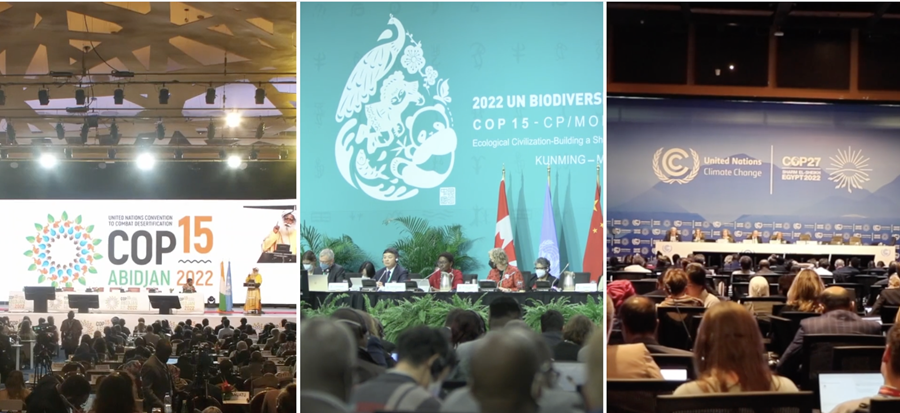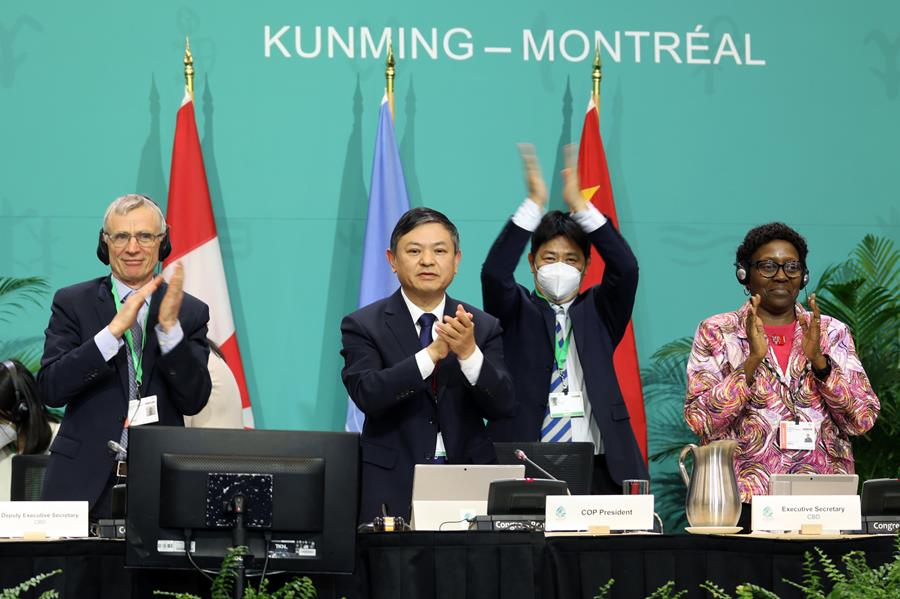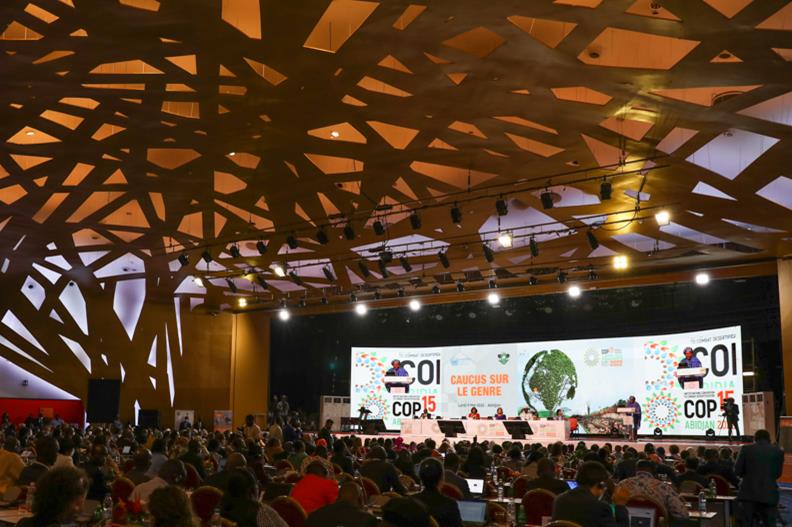Linking the Rio Conventions: Where we saw progress in 2022
14 February 2023
The three Rio Conventions have been linked—at least on paper—since the 1992 Earth Summit. While each treaty stands on its own, the UN Framework Convention on Climate Change (UNFCCC) and Convention on Biological Diversity (CBD), both of which were opened for signature at the Rio Earth Summit, and the UN Convention to Combat Desertification (UNCCD), the negotiation of which was called for in the Rio Earth Summit outcome—Agenda 21, remain intricately linked because they address interconnected and interdependent issues.
Former CBD Executive Secretary Elizabeth Mrema notes that “we cannot solve climate change without also solving biodiversity loss and land degradation: the solution to one will contribute to implementing [all three] Rio Conventions.” For instance, climate action can slow desertification and biodiversity loss. Deployment of renewable energy sources to mitigate climate change can replace unsustainable biomass fuels helping to preserve forest and land biodiversity. Curbing deforestation can help combat land degradation and biodiversity loss and reduce carbon dioxide emissions.

Despite formal recognition by the Secretariats, these linkages have been slow to emerge in negotiated outcomes. Governments are reluctant to expand the focus of legally binding treaties or to encroach on topics addressed under other multilateral environmental agreements (MEAs). Yet, growing recognition of the interconnectedness among sustainable development solutions has pressured parties to address these linkages.
In 2022, the UNFCCC, CBD, and UNCCD convened meetings of their respective Conferences of the Parties (COPs) amid the “triple planetary crisis” of climate change, pollution, and biodiversity loss. These meetings took place against the backdrop of an uneven pandemic recovery, armed conflict, food and energy insecurity, and record inflation, adding urgency to the talks. Did these crises spur innovative thinking in advancing collaborative, synergistic action? This ENB Linkages Update looks back at the outcomes of the three 2022 COPs to find answers.
Linkages and the Rio Conventions’ COP Outcomes

Kunming-Montreal Global Biodiversity Framework: The 2022 UN Biodiversity Conference (CBD COP 15) adopted the long-awaited Global Biodiversity Framework (GBF), which will guide biodiversity policy in the coming years. The new GBF spells out four overarching goals to live in harmony with nature by 2050, and a set of 23 targets to be reached by 2030—a timeline that aligns with the SDGs.
Target 8 of the GBF explicitly recognizes and seeks to leverage the linkages between climate and biodiversity action areas by “minimiz[ing] the impact of climate change and ocean acidification on biodiversity and increas[ing] its resilience through mitigation, adaptation, and disaster risk reduction actions... while minimizing negative and fostering positive impacts of climate action on biodiversity.”
Target 19 on resource mobilization for implementation of national biodiversity strategies and action plans (NBSAPs) seeks to optimize co-benefits and synergies of finance targeting the biodiversity and climate crises. In a separate decision, the parties requested the Global Environment Facility (GEF), which serves as a financial mechanism for all three Rio Conventions, to establish a Special Trust Fund to support the implementation of the GBF. To make limited funding go further and meet multiple objectives, they also encouraged the GEF, the UNCCD Land Degradation Neutrality Fund, and the Green Climate Fund (GCF) to “continue and intensify their work with a view to generating and increasing biodiversity co-benefits through complementary, coherent and collaborative interventions that generate greater impact as well as to enhance efforts to simultaneously tackle biodiversity loss, climate change and land degradation.”
Beyond the GBF package, however, the COP did not deliver a meaningful decision on biodiversity and climate change. Delegates debated text, eventually deciding to defer consideration of the item due to lack of consensus on reference to the principle of common but differentiated responsibilities, among other issues, which traces its origins to the climate process. The COP 15 decision merely requests parties and invites others to submit views and information on biodiversity and climate change.

Sharm El-Sheikh Implementation Plan: In a break with the past, the decisions adopted at the last two UNFCCC COPs have included “cover decisions” with many substantive directives. While the transparency and inclusiveness of the negotiations over these documents, which have been drafted by the COP Presidency and discussed during the final days of the COP, has been questioned, the outcomes have provided broad strokes for addressing linkages with topics addressed in other Rio Conventions.
The overarching cover decision from UNFCCC COP 27, titled the Sharm El-Sheikh Implementation Plan, recognizes the linkages between climate change, biodiversity, and land degradation by underscoring “the urgent need to address, in a comprehensive and synergetic manner, the interlinked global crises of climate change and biodiversity loss in the broader context of achieving the Sustainable Development Goals, as well as the vital importance of protecting, conserving, restoring and sustainably using nature and ecosystems for effective and sustainable climate action.”
In the mitigation section of the Implementation Plan, parties also “emphasize[] the importance of protecting, conserving and restoring nature and ecosystems to achieve the Paris Agreement temperature goal, including through forests and other terrestrial and marine ecosystems acting as sinks and reservoirs of greenhouse gases and by protecting biodiversity, while ensuring social and environmental safeguards.” While they recognize interlinkages among issues, these references are broad and contain no actionable language.

Abidjan Call: At the conclusion of UNCCD COP 15, Heads of State and Government issued the Abidjan Call, in which they “reaffirm [their] commitment to combat desertification, halt biodiversity loss and mitigate climate change in an integrated manner and therefore comply with the objectives of the three Rio Conventions.”
They also welcomed the Glasgow Leaders’ Declaration on Forests and Land Use and mandated the Ivorian President to bring the Abidjan Call to the attention of UNFCCC COP 27.
Nature-based Solutions: A tool for building linkages?
This review of COP decisions from 2022 suggests that recognition of interlinkages among the three processes has so far been weak. However, in 2022 countries introduced an additional dimension to their treatment of synergies among the Rio Conventions by, for the first time, spelling out the role of Nature-based Solutions (NbS) as an integrated approach to implementation.
In March, the UN Environment Assembly (UNEA) defined NbS as “actions to protect, conserve, restore, sustainably use and manage natural or modified terrestrial, freshwater, coastal and marine ecosystems which address social, economic and environmental challenges effectively and adaptively, while simultaneously providing human well-being, ecosystem services, resilience and biodiversity benefits.”
In a nutshell, NbS protect and restore nature for nature’s sake while at the same time improving peoples’ lives. According to the Nature-based Solutions Initiative, examples of NbS include:
- restoring and protecting forests and wetlands in catchments, to secure and regulate water supplies, support production of forest products, and protect communities and infrastructure from floods, soil erosion, and landslides;
- creating green roofs and walls and planting trees in cities, to moderate the impacts of heatwaves, capture storm water, and abate pollution, with positive outcomes for mental and physical health; and
- restoring coastal ecosystems, to protect communities and infrastructure from storm surges and erosion, and mitigate climate change through carbon sequestration.
Just two months after UNEA’s resolution, in the Abidjan Call, UNCCD parties called for land- and Nature-based Solutions to promote efficient, cost-effective, and nature friendly approaches toward a green recovery.
Similarly, the forest section of the Sharm El-Sheikh Implementation Plan “encourages Parties to consider... nature-based solutions or ecosystem-based approaches... for their mitigation and adaptation action while ensuring relevant social and environmental safeguards.”
Target 8 of the GBF envisions the use of “nature-based solutions and/or ecosystem-based approaches” in minimizing climate change impacts on biodiversity. Nature-based solutions and/or ecosystem-based approaches are also mentioned in Target 11 on restoring, maintaining, and enhancing nature’s contributions to people through ecosystem functions and services, including regulation of climate.
By including language on NbS in the COP outcomes, countries have demonstrated their readiness to consider options to expand the synergies and collaboration among the themes that the Conventions address. While NbS may be in the early stages of advancing formal synergies among the three Conventions, this agenda could help all three Conventions to have a strong impact on the ground while highlighting the importance of integrated approaches to solve the converging environmental crises.
This article was originally distributed in the Earth Negotiations Bulletin Linkages Update enewsletter and was written by Dr. Elena Kosolapova.